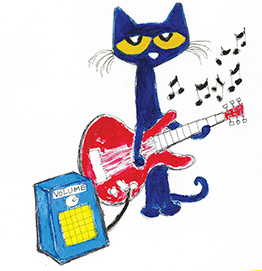[This Blog Post was inspired by the Music Production Podcast, episode 2.]
It’s been a while since I have written a blog post, but I finally have something to say! It’s time for me to make bad music. Yep! Completely uninteresting, don’t care what anyone thinks, no good, terrible bad music. Who knows, maybe I will release an album full of noises that don’t belong together.

I am going to write bad music with the attitude of Pete the Cat (dad reference)—no matter how awful it is, keep working to complete the track…because it’s all good. I have always been fascinated with music production, but I am willing to acknowledge that I’m not very good at it. Being a music “producer” was never really my thing. My passion has always been mixing records as a DJ. Now, unless you have been living under a rock, you may have noticed that some of the best DJs are also producers. In fact, it may be more accurate to say that some of the best producers are also DJs. They are certainly the ones headlining festivals around the world.
Like most professional DJs, I have recorded quite a few sets. All of them seem to suffer from the same problem—the sound quality is great as it’s happening, and then when you go back to listen to the recording, the mix sounds flat. Have you ever noticed when you listen to something albeit music, a tv show, a podcast, etc., how annoying it is when you need to crank the volume up just to achieve an acceptable level? You might notice this even more when using earbuds on a cell phone because the volume reaches the highest limit and whatever you are listening to is still not loud enough. This is only one example of the problem with recorded DJ mixes.
They also lose character. The highs are not as bright, the lows are not as punchy, and you are left with this otherwise flat recording. Solving this problem is one of the reasons that music production has piqued my interest, but it’s not the only reason.
The problem of flat recordings can be partially solved using a production technique known as mastering. During the mastering process, the recording engineer takes what you have and improves the sound by making it louder, brighter, and more exciting. Many of my recorded mixes have gone through some mastering, and all of them could still be improved. This is a testament to how difficult and tedious it is to achieve a commercial–quality sound.
Experimenting with mastering was really the catalyst for me to make the leap into music production. To make recorded mixes sound better, I use production software, virtual instruments, and I spend countless hours making subtle improvements to the overall sound. Through all of that, I have learned my way around music production, and I can’t wait to spend some time making bad music!
The point of making bad music is more about the process than it is the result. It’s about learning and completing what you’ve started. You would be hard pressed to find a producer who finishes every track they have started. In fact, I spend many nights fumbling around with sounds, testing various instruments, and I have nothing to show for it. Writing music takes time and unless you are a savant, it’s downright hard.
Like I tell my boys (and in the wise words of their elementary school teacher and “Tia”), “You can do hard things.” I can do hard things…even if I’m not good at them. I can make bad music for the sole purpose of finishing what I start. I have nothing to lose and everything to gain. It’s all about the process and the continual learning by doing. It’s about not giving up when the going gets tough. Giving yourself permission to make bad music takes away the stress of creating music. That is a concept that I can embrace, and as a result, I will very likely learn to create better music. In fact, that same concept is why I created the Jailbreak Sessions page…so that I can be FREE.
